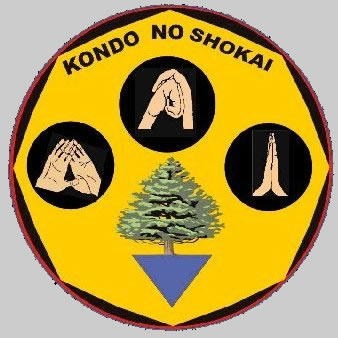|

|
Kondo No Shokai
Shorei-Ryu
Seal
|

|

Our mon (J. seal, crest) represents
several elements in the history of Shorei-ryu karate.
WORDS - In
English, Shorei-Ryu means encouragement school (or
style). In Okinawa, Shorei is
also used to describe the chuan-fa practiced in the Shaolin Temple on Southern China, the source of many
techniques that comprise the karate of Okinawa.
SHAPES -
The tomemitsu (J. three tumbling, tailed circles), a
symbol found throughout Asia, is used in Okinawa to symbolize karate.
Placed atop the tomemitsu is a pine tree. An
evergreen, it symbolizes nature, youth and the legacy of Choki
Motobu, one of Okinawa's greatest fighters.
The equilateral triangle represents the legacy of the Trias
family and the goal of equal amounts of power, speed and form in our ryu. The octagonal shape of the mon recognizes the eight-fold path taught by the
Indian Buddhist monk Taishi Daruma.
Daruma brought tea culture, Zen and chuan-fa (a precursor to karate) to China. One of his precepts
encourages us to remember that, when we fall(fail) in
life, we must get up and try again. The black outlined octagon represents Tong
Gee Hsiang and Hoy Yuan Ping, early teachers of
O-Sensei Robert A. Trias. The golden yellow octagon
represents the future masters of our ryu.
COLORS -
Green - in nature, green represents life. Active karateka
retain youthfulness throughout their lives. Golden yellow - the color of the
sun, a source of energy, prosperity. Black - fullness of life, knowledge and
finally wisdom. White - purity, emptiness, and lastly death, reminding those of
us who wear the seal of our mortality and responsibility to insure that Shorei-ryu Karate will persist over time.
This
emblem was commissioned and approved by Terry Sanders, style head of Shorei-ryu Karate and director of the Kondo No Shokai.
Approval was given by Philip Perales, Hanshi, the founder and director of the California Federation of Black
Belts.
Members of
these organizations retain exclusive rights to the use of this seal.


